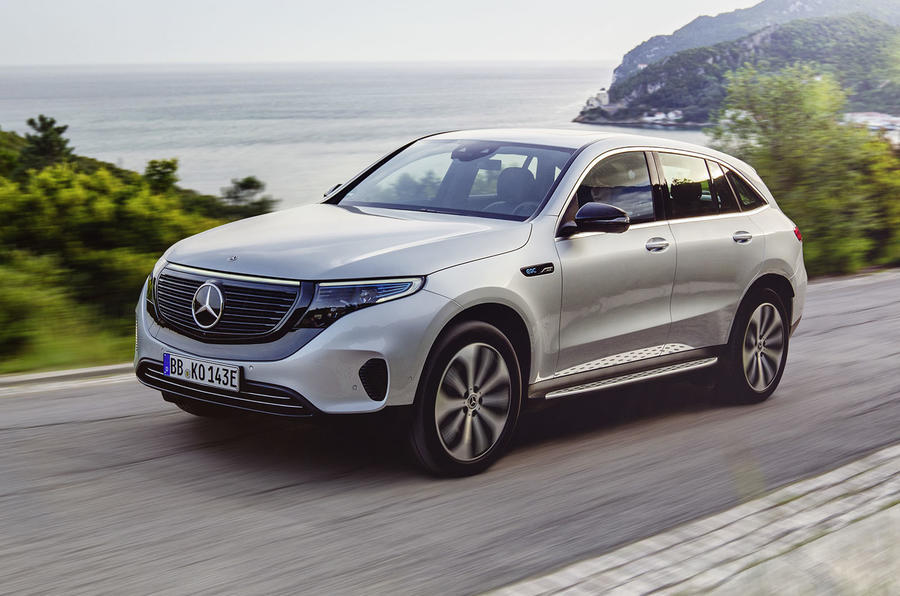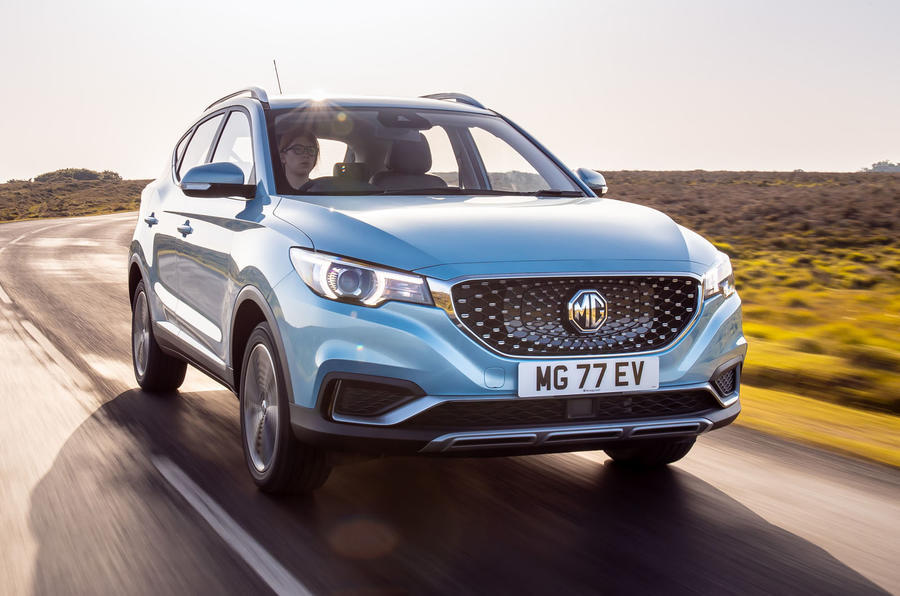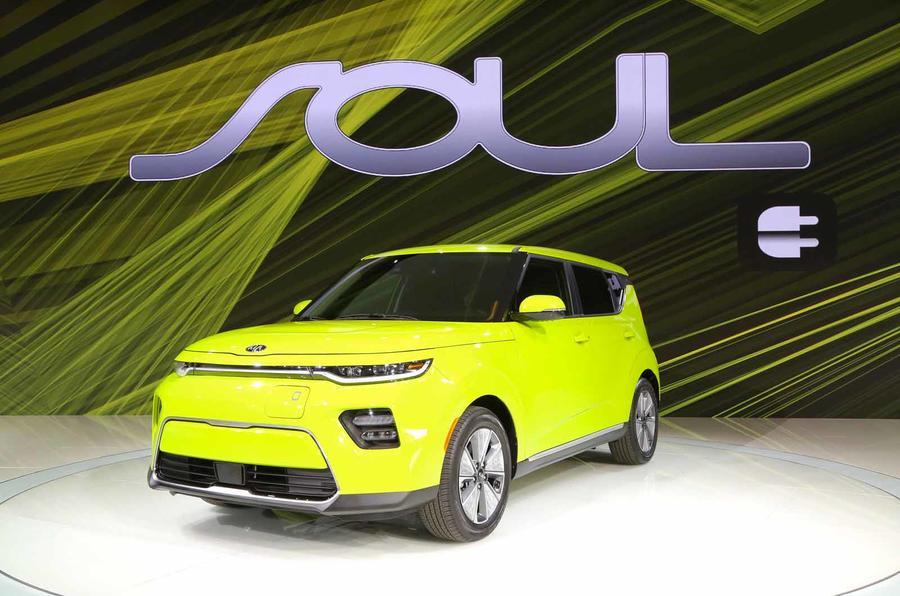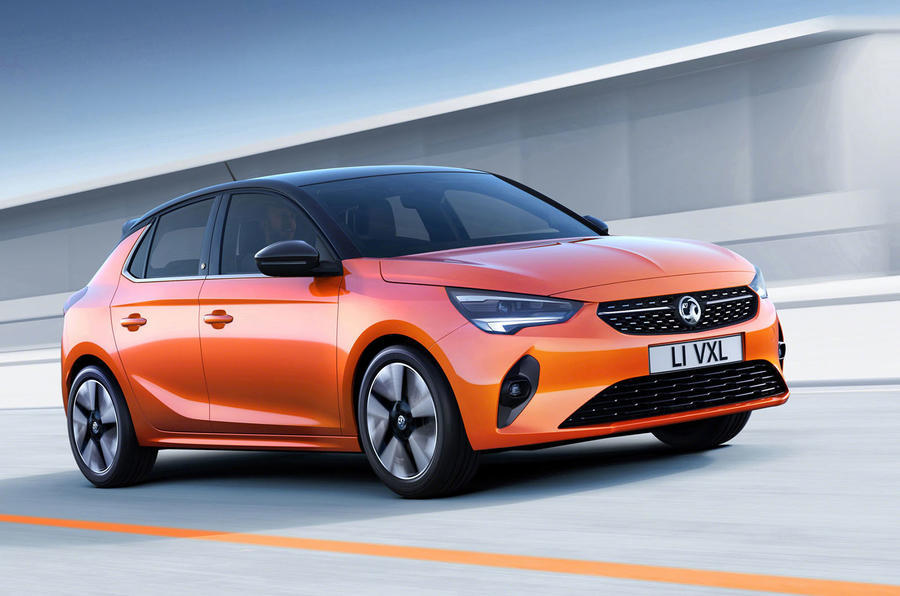Every debut and new model due to arrive this year and next, all in one place
Keeping track of every new car and knowing when they’re due to go on sale can be tough, especially if you’re only interested in EVs.
There are so many due to arrive over the next twelve months, so it’s worth learning how long you’ll be waiting for the one you want to go on sale. 2019 has already seen new entrants to the category from the likes of Audi, Mercedes and MG, with major launches from well-known electric pioneers such as Tesla, Nissan and Renault all set to follow soon.
The first half of 2020 looks to be even more stacked, as manufacturers work hard to meet increasingly tough emissions rules with the introduction of more all-electric models.
Read More: Complete guide to the best new cars in 2019
Here is our comprehensive list of what EVs are coming when in the car industry.
July
Mercedes-Benz EQC
The first car in Mercedes’ critical EQ electric range, the EQC will compete with the Tesla Model X and Jaguar I-Pace at the premium end of the market. It’s based on a heavily modified version of the existing GLC platform, with twin electric motors – one powering the front wheels and another the rears.
Combined power output is 402bhp, with 564lb ft of torque on tap to propel the 2425kg EQC to a limited 112mph top speed. In Sport mode, it will achieve the 0-62mph sprint in 5.1 seconds. Range is estimated at 249 miles on the WLTP cycle, which should translate to around 200 miles of real-world range.

MG ZS EV
MG’s first electric car, a version of the ZS compact SUV, was first revealed at the Guangzhou motor show in China back in November 2018, but was finally confirmed for UK customers earlier this year. We’ve since driven the high-riding EV, which uses a single electric motor to send 141bhp to the front wheels and a battery that’s good for 163 miles of range under the WLTP cycle, and MG has managed to sell out the first 1000 units within two weeks. Deliveries are due to begin in September.

August
Renault Zoe
In second-generation guise, the Zoe will be the first to use an all-new bespoke EV platform that allows for greater battery capacity. It should allow Renault’s compact electric supermini to achieve up to 250 miles of range per charge, a match for the existing R110’s NECD claimed range.
Heavily-camouflaged prototypes have been spotted testing, revealing a front end inspired by the upcoming 2019 Clio, a curvier rear-end, and a higher quality interior. Multiple power outputs and ranges are expected, but prices and performance figures have yet to be confirmed.
September
Audi e-tron Sportback
The first Audi saloon to go all-electric, the E-tron Sportback was first shown in concept form way back in 2017 at the Shanghai motor show. The production version will share a platform with the E-tron SUV, which will have been on sale for six months by the time this model reaches UK showrooms.
It will deliver a sportier drive, according to Audi, along with a coupe-like body style. The powertrain will likely be identical, meaning twin electric motors delivering 355bhp and a battery capable of 250 miles between charges. Using Boost mode, 0-60mph times should be in the mid 5-seconds.
Porsche Taycan
Is it hyperbole to say the Taycan will be the most important car to ever roll out of Porsche’s Stuttgart headquarters? Maybe not, but the sporting four-door EV will certainly play a big part in the company’s future. It has seen Porsche invest £5.3 billion in electrification projects, and will likely influence future models including the iconic 911.
Previewed as the Mission E, the production version will debut at the Frankfurt motor show, with pricing to put it between the Cayenne SUV and Panamera saloon.

Hyundai Ioniq
Although little is known about Hyundai’s plans for its refreshed Ioniq, development mules have been spotted testing in the US and it is a safe bet that the company will use advances in its electric powertrains to overhaul the EV version towards the end of 2019. The maximum range should therefore be a close match to the Kona Electric SUV, with performance figures to match. It will be joined by hybrid and PHEV options.
October
Aston Martin Rapide E
The first electric Aston will be more of a taster of things to come from Gaydon. The limited-run luxury saloon will be based on the existing Rapide, but swap its petrol drivetrain for twin electric motors that send 602bhp and somewhere in the region of 738lb ft of torque to the rear wheels. Weight should be almost on par with the petrol model.
Aston is reportedly looking for a 0-60mph time of four seconds, to put the electric version on par with the Rapide S. Aston’s focus has been on ‘repeatable performance’, meaning foot-to-floor acceleration runs that can be done without resulting in a rapidly sapped battery, and a quoted 155mph top speed that can be maintained for ten minutes. No word on pricing as yet.
Kia Soul EV
An updated design and upgraded interior aren’t the only changes for the second-generation Soul EV – it also borrows a powertrain from the e-Niro crossover. With Europe not getting any kind of combustion engined-model, the sole Soul will be electric, with a 201bhp power output from a 64kWh liquid-cooled lithium-ion battery pack.
Known as the e-Soul in other markets, but changed for the UK for obvious reasons, the Soul EV’s range should at least match the 279 miles quoted for the e-Niro. A 10.25in touchscreen with Apple CarPlay and Android Auto should improve things inside the cabin, too.

Mini Electric
A potential watershed moment for EVs, the upcoming Mini could become the very first electric hot hatchback. It is set to arrive with a powertrain influenced by the one found in the BMW i3, and will be built on an adapted version of the platform currently being used by the Mini hatchback.
Near-instant torque and a 0-62mph time of less than even seconds mean it should earn its Cooper branding. It will be branded Cooper S E in other markets, but will be known as the Mini Electric here in the UK. Range is expected to be between 120 and 140 miles, which may be lower than its immediate rivals, but handling is promised to be a lot closer to the original 60’s-era Mini – which sounds like a recipe for success to us.
Polestar 2
Volvo’s electric sub-brand will introduce its first pure EV in 2019, with a winter reveal predicted but nothing as yet confirmed. The Polestar 2 will be a mid-sized saloon priced between £30,000 and £50,000, offer a range as high as 350 miles, and as much as 400bhp on tap.
It will almost certainly take design cues from the 40.2 concept shown in early 2017, as well as the 40.1 concept that went on to inspire the Volvo XC40 compact SUV. It is unknown if Polestar will use a similar sales model to its flagship 1 performance hybrid, which will be sold by subscription.
November
DS 3 Crossback E-Tense
Set to share its CMP platform with the upcoming Vauxhall Corsa and Peugeot 208, the 3 Crossback will be the first electric DS model and beat its PS group brethren to market by several months.
Designed as a direct rival for the Volvo XC40 and Audi Q2, the Crossback will focus on comfortable, high-end interiors, distinctive exterior styling inspired by the 7 Crossback, and an electric range of around 180 miles from a 50kWh lithium-ion battery. 0-62mph performance is estimated at 8.7 seconds, with a top speed of 93mph.
Seat Mii Electric
It has taken far longer to arrive than the Volkswagen e-Up with which it shares a platform, but Seat’s electric city car will finally arrive towards the end of 2019 and go on sale in early 2020. It may be a tough sell, costing significantly more than the petrol version and needing to undercut the VW to appeal to customers, but its 36.8kWh battery pack will deliver a WLTP-certified range of 162 miles – 79 miles more than the ageing VW e-Up.
Volkswagen ID 3
Designed and built as a pure electric car, the ID hatchback will be a crucial launch for VW. It will closely match the Golf hatchback in size, and the company is anticipating a price close to that of a Golf diesel, making it a more affordable EV than existing models.
It will be built on the modular MEB platform, and offer a variety of battery options for a range of between 249 and 373 miles between charges. According to VW, the final design will remain true to the original concept, which was first revealed in 2016 and went on to inspire several other ID models, which are all due to launch over the next five years.

Volvo XC40 Electric
The company’s very first electric vehicle, the XC40 EV will arrive after the Polestar 2 and establish a pattern for the company: electric versions of existing models, rather than brand new ones built around batteries and electric motors. That means an electric XC90 will follow.
Hardware will be shared with Polestar, but performance figures and electric range has not yet been confirmed.
December
Audi Q4 e-tron
The concept version of Audi’s upcoming mainstream electric SUV was revealed at 2019’s Geneva motor show, but a production version isn’t set to arrive until 2020 as the firm’s fifth electric model. It borrows styling from the e-tron, and will slot in beneath the Q5 in terms of size.
It will use the VW Group’s MEB platform, rather than the adapted MQ platform used by the larger e-tron. Twin motors will provide Quattro all-wheel drive and up to 302bhp – around 100bhp less than the full-size e-tron but 100 more than MEB-based hatchbacks like the VW ID.
Honda e
It might arrive as a five-door, rather than the three-door layout previewed by the well-received concept shown at 2017’s Frankfurt motor show, but the production version of Honda’s compact electric city car promises to retain its retro-inspired looks. The company even went back to the drawing board after the reveal to make sure the real thing stayed as true to the concept as possible.
The Urban EV will arrive on a unique new platform and a predicted range of 155 miles, and is set to become the brand’s first European electric car. It should be smaller than the Jazz, but no performance figures have been officially announced as of January 2019.

Nissan Leaf SUV
Nissan is responsible for two of the most popular cars within their categories on UK roads today. The Qashqai didn’t invent the crossover hatch, but it did popularise it, and the Leaf has quickly become the go-to electric car for the masses thanks to a sensible range and hatchback proportions.
The upcoming Leaf SUV is on track to mash these two ideas together, and is almost certain to become a sales hit when it goes on sale. Nissan has pledged to stay true to its IMx concept, which should mean distinctive looks, longer range and more power when it eventually goes on sale.
Peugeot e-208
After being on sale for six years, only the 208 GTi has managed to truly impressed us, so rumours that its replacement will appear in pure-electric form should be guaranteed to get hot hatchback fans excited. The standard 208 will also get an electric version, courtesy of the CMP platform which allows for multiple powertrains.
It won’t get a bespoke design, so will instead share its looks with the petrol and diesel versions when it arrives towards the end of the year. Performance details are still under wraps, but a range of at least 186 miles has been promised.

Spring 2020
Vauxhall Corsa-e
Due not long after the launch of the petrol version, the electric Corsa will almost certainly prove popular in the UK. The Corsa is regularly one of the country’s most popular cars, and the new version will be the first built under PSA ownership.
It will use the same CMP platform as the Peugeot 208 and DS 3 Crossback, and provide an electric range of up to 250 miles. A brand new visual style, including redesigned grille and all-glass facia has been revealed ahead of launch, and apparently achieved all within the space of two years following PSA’s buyout of the brand.

Skoda Citigo-e
The first electric Skoda will be an adapted version of its small city car. It will deliver a range of around 186 miles, which is significantly more than the Volkswagen e-Up sister car with which it shares a platform. It will then be followed by a dedicated electric model built on the Volkswagen Group’s MEB platform, although few details are known at present.
Fiat 500e
Little is known about the all-new electric Fiat 500, which is understood to be set for a Geneva 2020 reveal, but disguised mules have already been spotted testing in the USA. Fiat has committed 700 million Euros into the project, and will manufacture the car at a new production line in Mirafiori, Italy. The brand has yet to announce whether the electric 500 will be rear-driven like the original iconic model, or if a hot Abarth version would follow later.
Summer 2020
BMW iX3
An electric version of BMW’s X3 SUV, the iX3 will arrive with a new four-wheel drive powertrain comprised of two electric motors – one for the front axle and another for the rear. It will closely resemble the petrol-powered X3, rather than take any design inspiration from the more radical i3 and i8, to become only the company’s second pure electric car. Each motor should develop around 270bhp from a 70kWh battery, and be capable of around 249 miles of WLTP-certified range.

Ford Mach E
Set to be one of the Blue Oval’s most important, and possibly most controversial, new cars to date, the Mach E is an electric crossover inspired by the iconic Mustang muscle car, built from the ground up on a new EV platform. Set to be revealed later this year and go on sale in 2020, the car has yet to be officially named but Ford has applied for the Mach E trademark. It originally considered ‘Mach One’, but apparently ditched the idea because of negative customer feedback over the connection to classic Mustang models of yesteryear.
Skoda Vision E
Set to arrive in SUV and coupe bodystyles in a similar approach to the Kodiaq and China-only Kodiaq GT coupé, Skoda’s first dedicated electric car isn’t expected to go on sale until 2021, but a production version should be revealed in 2020. Both versions will be based on the VW Group’s MEB platform, which is being used across all the company’s brands for electric vehicles. Range has been estimated at at least 300 miles, and pricing will be comparable to an upper-range Kodiaq, meaning roughly £30,000.
Seat el-Born
The first non-VW model to launch on the MEB platform, the el-Born will have a very similar powertrain and engineering to the ID hatchback, but opts for sportier styling and a more engaging driving experience. Range is predicted to be around 260 miles between charges, while the 201bhp electric motor shown in the concept version promises a 0-62mph sprint of around 7.5 seconds.

Tesla Model Y
Revealed in March 2019, but not expected to go on sale in the US for at least eighteen months after and the UK even longer, the sister car to the Model 3 will arrive as a much-in-demand compact SUV with the option to add a third row – which could make it the go-to EV for large families. It share a platform and powertrain with the Model 3 saloon, which will hopefully speed up Tesla’s ability to deliver cars on time.
A more advanced version of the company’s ‘supercomputer’ semi-autonomous driving system is also predicted, as is a more potent Performance variant.
Late 2020
Pininfarina Battista
Only 150 Battista hypercars are set to be produced, but with individual motors for each wheel producing a total 1900bhp, it promises to be powerful in the extreme. Lucky customers will see deliveries towards the end of 2020 from the design house-turned-manufacturer, which has partnered with Rimac for the underlying powertrain.
Rivian R1T
A surprise announcement at 2018’s Los Angeles motor show, despite the company behind it having been first formed in 2009, the Rivian R1T is a pick-up truck reimagined for an EV generation. It has clever packaging that makes the most of available space, while the underlying powertrain promises to deliver as much as 754bhp and a 0-60mph time of under three seconds.
It is set to go into production in late 2020, which might be enough time to beat Tesla’s upcoming pick-up to the punch.

READ MORE
Complete list of new cars in 2019
Top 10 best electric cars 2019
Source: Autocar
